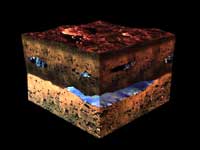Mars Express has the sophisticated science to find the water ice on Mars

Artist’s impression of water under the Martian surface (ESA 2001. Illustration by Medialab)
“The presence of such a large amount of water ice under Mars`s surface is very surprising. Especially so close to the surface!” says Gerhard Schwehm, Head of the Planetary Missions Division at ESA. The team working on ESA`s Mars Express, the next mission to the Red Planet, is thrilled by NASA`s Mars Odyssey detection of hydrogen-rich layers under the Martian surface. This hydrogen indicates the presence of water ice in the top surface of the Martian soil in a large region surrounding the planet`s south pole. ESA`s Mars Express, ready for launching in June 2003, has the tools for searching much deeper below the surface, down to a few kilometres.
“Mars Express will give a more global picture of where the water is and how deep,” says Patrick Martin, ESA deputy project scientist for the Mars Express mission.
The radar sounder on board Mars Express, MARSIS, will map the subsurface structure from a depth of about a hundred metres to as much as a few kilometres. This is in contrast with the Mars Odyssey, which can sense surface compositions to a depth of only one metre.
The cameras on Mars Express will map the minerals at a very high resolution and report how they are distributed on the Martian surface. This kind of data is crucial to understand the distribution of subsurface water. The other four instruments on board Mars Express (seven in total) will observe the atmosphere and reveal processes by which water vapour and other atmospheric gases could have escaped into space.
Knowing about the water distribution on and under the surface of Mars is essential, since water is needed for the appearance of life. Also, water distribution will help understand the geological history of the planet, and ultimately provide new clues about formation of our Solar System and evolution of Earth. Moreover, the presence of water puts mankind a step closer to the human exploration of the Red Planet. In its exciting Aurora programme, ESA is considering systems that could be used in future extraterrestrial human colonies or stations.
Search for life
Mars Express will also deploy a lander on Mars, called Beagle 2. Beagle 2 will parachute down to the Martian surface, probably close to the equator, and is especially equipped to look for signatures of life. It will do so both on and below the surface, since Mars`s harsh atmosphere would almost certainly have destroyed any evidence for life on the surface. Beagle 2 will use a `mole` to retrieve samples of soil to a depth of 1.5 metres, and will become the first lander to look directly for evidences of life on the Red Planet since NASA`s Viking in 1976.
Media Contact
More Information:
http://sci.esa.intAll latest news from the category: Physics and Astronomy
This area deals with the fundamental laws and building blocks of nature and how they interact, the properties and the behavior of matter, and research into space and time and their structures.
innovations-report provides in-depth reports and articles on subjects such as astrophysics, laser technologies, nuclear, quantum, particle and solid-state physics, nanotechnologies, planetary research and findings (Mars, Venus) and developments related to the Hubble Telescope.
Newest articles

You are What You Eat—Stanford Study Links Fiber to Anti-Cancer Gene Modulation
The Fiber Gap: A Growing Concern in American Diets Fiber is well known to be an important part of a healthy diet, yet less than 10% of Americans eat the minimum recommended…

Trust Your Gut—RNA-Protein Discovery for Better Immunity
HIRI researchers uncover control mechanisms of polysaccharide utilization in Bacteroides thetaiotaomicron. Researchers at the Helmholtz Institute for RNA-based Infection Research (HIRI) and the Julius-Maximilians-Universität (JMU) in Würzburg have identified a…

ASXL1 Mutation: The Hidden Trigger Behind Blood Cancers and Inflammation
Scientists show how a mutated gene harms red and white blood cells. LA JOLLA, CA—Scientists at La Jolla Institute for Immunology (LJI) have discovered how a mutated gene kicks off…



